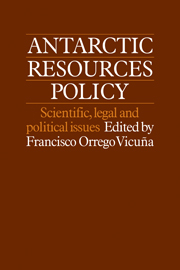Book contents
- Frontmatter
- Contents
- List of contributors
- 1 Antarctic resources policy: an introduction
- Part one The state of Antarctic knowledge and experience
- 2 Antarctica: its history and development
- 3 The living resources of the Southern Ocean: a scientific overview
- 4 The mineral resources of Antarctica: progress in their identification
- 5 Environmental factors in the development of Antarctica
- 6 Cooperation in the Antarctic: a quarter of a century's experience
- Part two The policy for the conservation of the living resources of Antarctica
- Part three The policy for the exploration and exploitation of the mineral resources of Antarctica
- Part four Issues on Antarctica and the law of the sea
- Part five The policy for Antarctic cooperation
5 - Environmental factors in the development of Antarctica
Published online by Cambridge University Press: 06 July 2010
- Frontmatter
- Contents
- List of contributors
- 1 Antarctic resources policy: an introduction
- Part one The state of Antarctic knowledge and experience
- 2 Antarctica: its history and development
- 3 The living resources of the Southern Ocean: a scientific overview
- 4 The mineral resources of Antarctica: progress in their identification
- 5 Environmental factors in the development of Antarctica
- 6 Cooperation in the Antarctic: a quarter of a century's experience
- Part two The policy for the conservation of the living resources of Antarctica
- Part three The policy for the exploration and exploitation of the mineral resources of Antarctica
- Part four Issues on Antarctica and the law of the sea
- Part five The policy for Antarctic cooperation
Summary
Definitions
In this paper, conservation is used in the sense of the World Conservation Strategy (IUCN/UNEP/WWF, 1980) to mean the management of renewable natural resources for optimum sustainable yield. Development is the practice whereby natural resources are utilised by man, commonly with accompanying modification in the environments in which they occur. The management of development is the process by which development activities are constrained so that they do not cause unacceptable harm or inappropriate depletion of the resource, hence ensuring that conservation occurs.
Environmental concerns as a major constraint on Antarctic development
As the prospects for economic development of the natural resources of Antarctica have improved, concern about the consequential impacts on the environment has mounted in parallel. Conservation philosophies have strongly influenced development policies since the inception of the Antarctic Treaty. At the second SCAR Symposium on Antarctic Biology in 1968 it was stated that three objectives for conservation were implicit in the Treaty and had been developed in part by the Agreed Measures for the Conservation of Flora and Fauna in the Antarctic (Carrick, 1964; Anderson, 1968; Holdgate, 1970).
These were:
(1) the protection of the landscape, flora and fauna south of latitude 60°S;
(2) protection of the ecosystems of islands in the sub-Antarctic north of 60°S within the SCAR area of interest;
(3) the wise management of living resources in the Southern Ocean ‘so that a protein crop can be taken without irreversible damage to the ecosystem or the undue depletion of the cropped species’ (Carrick, 1964; Murphy, 1964; Holdgate, 1970; Gulland, 1977).
- Type
- Chapter
- Information
- Antarctic Resources PolicyScientific, Legal and Political Issues, pp. 77 - 102Publisher: Cambridge University PressPrint publication year: 1983
- 3
- Cited by



